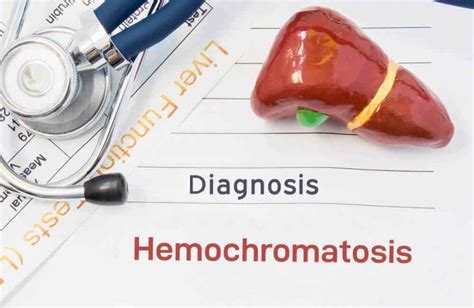Hereditary hemochromatosis is a genetic disorder characterized by excessive iron accumulation in the body, leading to various health problems. It is a common genetic disorder in people of European descent, affecting approximately 1 in 300 individuals. In this article, we will discuss the causes, symptoms, and treatment of hereditary hemochromatosis, as well as its ICD-10 classification.
Causes of Hereditary Hemochromatosis
Hereditary hemochromatosis is caused by mutations in the HFE gene, which codes for a protein responsible for regulating iron absorption in the gut. The most common mutations are C282Y and H63D, which affect the function of the HFE protein, leading to increased iron absorption and accumulation in the body. The disorder is inherited in an autosomal recessive pattern, meaning that an individual must inherit two copies of the mutated gene (one from each parent) to develop the condition.
Symptoms of Hereditary Hemochromatosis
The symptoms of hereditary hemochromatosis can vary depending on the severity of the condition and the organs affected. Common symptoms include:
- Fatigue and weakness
- Joint pain and arthritis
- Skin discoloration (bronze or grayish skin)
- Abdominal pain and liver disease
- Heart problems, such as cardiomyopathy and arrhythmias
- Diabetes and pancreatic damage
- Infertility and erectile dysfunction in men
Diagnosis of Hereditary Hemochromatosis
Hereditary hemochromatosis can be diagnosed through a combination of medical history, physical examination, laboratory tests, and genetic testing. Laboratory tests may include:
- Iron studies, such as serum iron, ferritin, and transferrin saturation
- Liver function tests, such as alanine transaminase (ALT) and aspartate transaminase (AST)
- Complete blood count (CBC) to rule out other causes of anemia
- Genetic testing to identify HFE gene mutations
ICD-10 Classification of Hereditary Hemochromatosis
The ICD-10 classification for hereditary hemochromatosis is E83.1, which falls under the category of "Disorders of iron metabolism."

Treatment of Hereditary Hemochromatosis
Treatment for hereditary hemochromatosis focuses on reducing iron accumulation in the body and managing related health problems. Treatment options may include:
- Phlebotomy (bloodletting) to remove excess iron from the body
- Chelation therapy to bind and remove iron from the body
- Vitamin and mineral supplements to manage related deficiencies
- Medications to manage symptoms, such as pain relief and anti-inflammatory agents
- Lifestyle modifications, such as avoiding iron-rich foods and reducing alcohol consumption
Complications of Untreated Hereditary Hemochromatosis
Untreated hereditary hemochromatosis can lead to various complications, including:
- Liver damage and cirrhosis
- Heart problems, such as cardiomyopathy and arrhythmias
- Pancreatic damage and diabetes
- Infertility and erectile dysfunction in men
- Increased risk of certain cancers, such as liver and pancreatic cancer
Gallery of Hereditary Hemochromatosis






FAQs
What is hereditary hemochromatosis?
+Hereditary hemochromatosis is a genetic disorder characterized by excessive iron accumulation in the body, leading to various health problems.
What are the symptoms of hereditary hemochromatosis?
+Common symptoms include fatigue, joint pain, skin discoloration, abdominal pain, and liver disease.
How is hereditary hemochromatosis diagnosed?
+Diagnosis is made through a combination of medical history, physical examination, laboratory tests, and genetic testing.
In conclusion, hereditary hemochromatosis is a genetic disorder that requires prompt diagnosis and treatment to prevent complications. If you suspect you or a family member may have hereditary hemochromatosis, consult a healthcare professional for proper evaluation and care.
